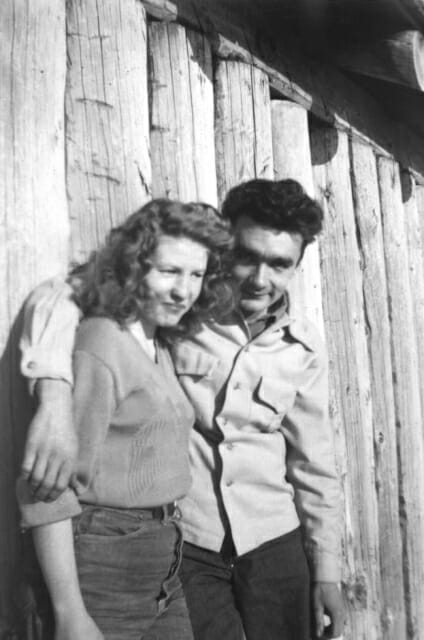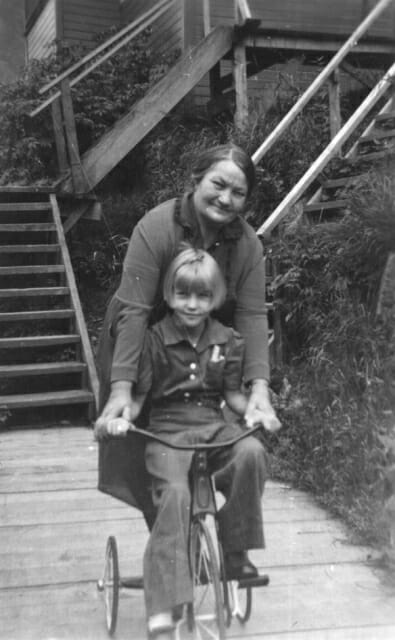Gastineau Channel Memories
Ahrensfeld, Bill and Gloria (Maki)
Gloria (Maki) Ahrensfeld
I was born in Diamondville, Wyoming on November 13, 1930 of Finnish parents. I lost my mother to tuberculosis when I was two. My dad and his parents moved to a farm near McCall, Idaho from where I attended a one room school house out in the country. I didn?t speak English until the second grade as the first grade teacher was also Finnish. My second grade teacher kept me after school to learn English. To this day I still keep in touch with her.
My dad remarried and his wife didn?t treat me well so I ran back to the farm. My grandparents were very poor so they thought about an orphanage for me. My maternal grandmother, Selma Maki, heard about this and she came down to Idaho to get me. We took a bus to Seattle, then caught the old Alaska Steamship Columbia. I arrived in Juneau on July 10, 1939, to a beautiful sunny day. We were met at the Alaska Steam dock by Patsy Ann, the town dog loved by everyone. I used to pet her whenever I saw her.
My grandmother Selma first arrived in Alaska in 1932, heading to Anchorage. She soon moved to Juneau where she was a cleaning lady at a friend?s tavern called Matt?s Place, located near the Cold Storage. Her two sons, Walter and Russell, worked at the AJ Gold Mine until it closed in 1944. In later years, my Uncle Russell was a projectionist at the 20th Century Theater until he moved to Idaho.
Selma nearly lost her life when a huge dirt slide came roaring across Gastineau Avenue, off Mt. Roberts on November 22, 1936, during a heavy rain storm. She was visiting a friend on Gastineau when the walls started closing in on her. She was very lucky. Matt?s Place where she worked was located directly across from the slide so she and other volunteers helped serve food and liquid refreshments to the workers who were digging for survivors.
I lived with my grandmother Selma, her daughter Mary and her husband Bill, plus Walter and Russell on Gastineau Avenue until our home was built on Douglas Island, near the town of Douglas. Selma, or ?Aiti? as we called her (Finnish for mother), worked then for the Alaska Laundry. She would walk to work across the Douglas Bridge to Juneau whenever possible.
Selma bought the Douglas beach property for $500 in the 30?s. I helped her put in a dirt floor basement and clear many stumps off the land, by hand. She loved to garden, raised vegetables and had raspberry bushes. I would see her puttering in the garden even if it was raining. She was an amazing lady. She became a United States citizen on February 20, 1945.
Winters were very cold and fierce in the 40?s. We would get the ?Taku? winds that blew from all directions it seemed, but came off the Juneau Ice Field. The salt spray from Gastineau Channel would get so thick on the windows in the winter we could hardly see out. In many winters our water would freeze so we carried water from the neighbors or town. Waiting for the school bus in the winter was no fun. Sometimes they would cancel school and my friend and I would go back to the house and warm our feet in the old oil stove oven! We weren?t allowed to wear pants in school, just going there.
There were a lot of Finns living in the Juneau- Douglas area in the 1940?s and 1950?s. I attended Douglas School until I graduated in 1950. There were eight of us in our senior class and three of us are still living here. Nancy (Niemi) Shanley, who grew up on Douglas Island is still one of my close friends. Our families kept close touch, visiting at a moment?s notice as we didn?t have phones.
Selma and her son Walter moved to Tenakee. Her reason was to help cure her rheumatism by soaking in the hot springs. It must have helped as she began to attend dances held at the Blue Moon Caf?. She later developed cancer and she passed away at the Sitka Pioneers Home in 1961.
After graduation, I worked temporarily at the Alaska Coastal Airlines office. While working at the Department of Taxation I met my future husband Bill Ahrensfeld. He had arrived in Juneau on December 10, 1950, being hired by Shell Simmons of Alaska Coastal as a mechanic. The airline operated from the downtown Juneau Seadrome using various aircrafts such as the Lockheed Vega, Bellanca, PBY, and Grumman Goose. They also used a Kingbird which flew to Tulsequah Mine in B.C.
Bill was born in Manhattan, New York on November 19, 1927 to German parents. His grandmother came from Austria. Before coming west he had worked for a sailmaker in City Island, N.Y. and was in the Army in the 40?s, stationed in the Philippines. The west called him so he drove from New York to Seattle and worked for Boeing for a short time. He noticed an ad in the paper for a mechanic job in Juneau and was hired immediately.
Bill owned a Cessna 120 when he first arrived in Juneau. He swept me off my feet by giving me my very first plane ride over Mendenhall Glacier! We used to take quick trips to Skagway and on June 2, 1951 we developed there and were married by a commissioner at the Presbyterian Manse.
Since we have been married, we have owned several small planes. Bill has restored both a Super Cub and an Aeronca Sedan. We?ve flown to many beaches, hiked up on Taku Glacier and visited many communities in Southeast Alaska and Yukon Territory and British Columbia.
In 1978, I hiked the Chilkoot trail with our daughter Kayla and friends. It took us 5 days to hike 33 miles and the elevation on the pass was 3550 feet. Scenery was fantastic, but once is enough!
Bill retired from Alaska Airlines after working 42 years as an A and E mechanic. We have raised two children, Kurt Walter and Kayla Miriam. They have blessed us with six grandchildren. Kurt is a civil engineer and lives in Kirkland, Washington and Kayla is an artist and works as a framer in a Juneau gallery. My father passed away in the 40?s.
Bill belongs to the Elks and the Eagles and I have belonged to the Gastineau Philatelic Society since 1970. We both belong to the Moose and the Pioneers, for which I was Auxiliary president in 1982. I have been here 61 years and Bill for 50; we are glad that we saw Juneau when it was the small friendly town of earlier years. One thing that will never change is the fantastic scenery of this area, especially in Atlin, B.C. where our log cabin ?Huvila? (Finnish for summer place) awaits our return to the shores of the scenic and peaceful Lake Atlin.
 |
Gloria Ahrensfeld, 1952. |
 |
Grandmother Selma Maki and Gloria. |
 |
Walter, Selma, and Russell Maki. |
